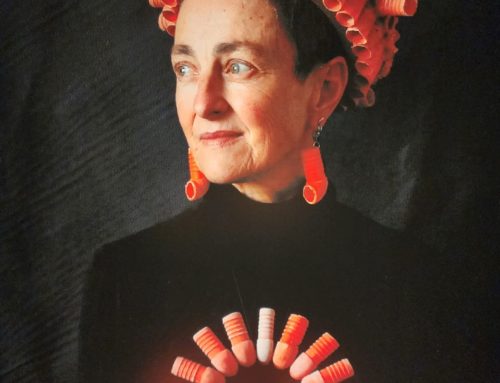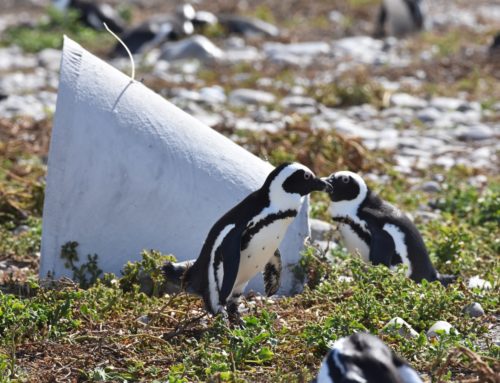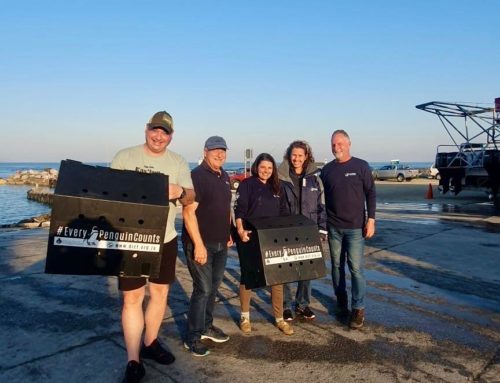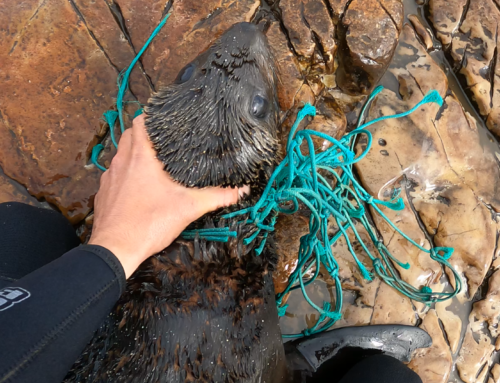Sawchuk tagged white shark female update
March 24, 2015 by dyertrust
Back in October 2014, our team deployed a pop off archival or ‘PAT’ transmitter on a female white shark. We named the shark “Sawchuk” after the family who kindly donated towards her tag.
Sawchuk with her tag clearly visible after she was tagged and tracked the first time in November 2014.
These tags give off a signal which can be tracked and thus a route can be mapped which gives you and indication of where this shark had spent her time. Normally Alison Towner, resident Marine Biologist for the DICT would do this with her crew on board of Lwazi- the VW sponsored research vessel of the DICT.
The shark proceeded to spend the rest of November 2014 in the Gansbaai region and was sighted and photographed by cage diving vessels over the time period. In Early December 2014, the shark departed the bay and on the 17th of December her tag detached and began to transmit a signal from past Cape Agulhas . PAT tags are wonderful devices, but data quality relies a lot on retrieval of the transmitter. Often the likelihood of getting the PAT tag back is like finding a needle in a haystack. The tag is the size of a cigar with a golf ball sized float at the end and can be buried under meters of thick kelp, debris or simply wash offshore never to be seen again! One white shark PAT tag was flushed down the toilet by a Mozambican fishermen last year and miraculously the tag was returned! At the Dyer Island Conservation Trust, we have spent years building collaborative relationships with our NGO partners along the coast.
This time it was Thulani from Cape Nature who came to our rescue and returned our tag after a local found it washed up on Struisbaai beach and dropped it at their on site office. The tag is now being downloaded and the data used for analysis. We suspect the data captured may reflect the first leg of a juvenile female white sharks easterly migration. This summer behavior is known in white sharks which visit Western Cape aggregation sites such as Gansbaai. Struisbaai, is renowned for some of the countries most productive yellowtail catches in summer months and the shark could have been ‘resting and refueling’ to continue on with her journey or temporarily residing in this area. It is also an area which young white sharks have been landed during angling competitions only to be released stressed and damaged. This data further highlights the importance of the area for the species with regards to management of such events. We are incredibly lucky to have gotten the transmitter back for download which allows us to see the environmental characteristics of the water she was utilizing, and information on how she used cage diving versus other sites.
From Gansbaai to the Southern tip of Africa in a couple of days- this just highlight’s how quickly these fish can move when they want to!
The Sawchuk family, who kindly donated towards the cost of the tag, had the following to say when we asked what shark conservation means to them…
“Sharks are a valuable part of our oceans ecosystems, not a terror from the deep. They are needed to keep the ocean in balance, but we are slowly losing them to fear and superstition. They are beautiful and magnificent creatures who need our help. To see them silently glide through the water past you, then you understand the soft side to sharks, not jaws but the real truth of it. More people get killed year from cows than from sharks but we still fear them instead of trying to understand and protect them. For all our fear, they should be afraid of us, we kill more of them than they ever have. To be able to see them up close was an experience we will never forget and cherish for our life time, we hope that future generations are able to be in awe of sharks just like we were for many years to come. We were all unsure of what would happen from this experience but we all gained more respect for sharks.
We hope that this research helps us understand and save sharks. “
VWSA’s logistical sponsorship of Lwazi’s research fuel makes the tagging and tracking of these animals easier, helping us to not only learn as much as possible about them in the process but also to gain ambassadors for this species across the world by providing them with the opportunity to become involved in the research.





